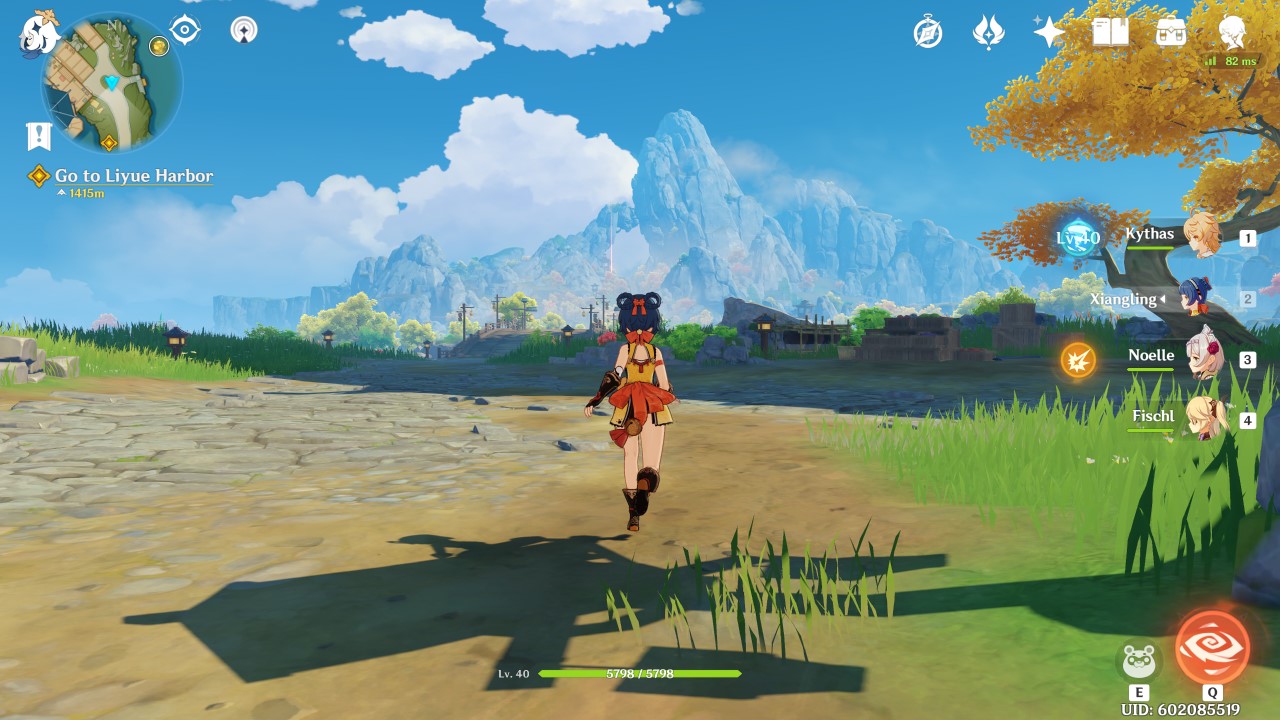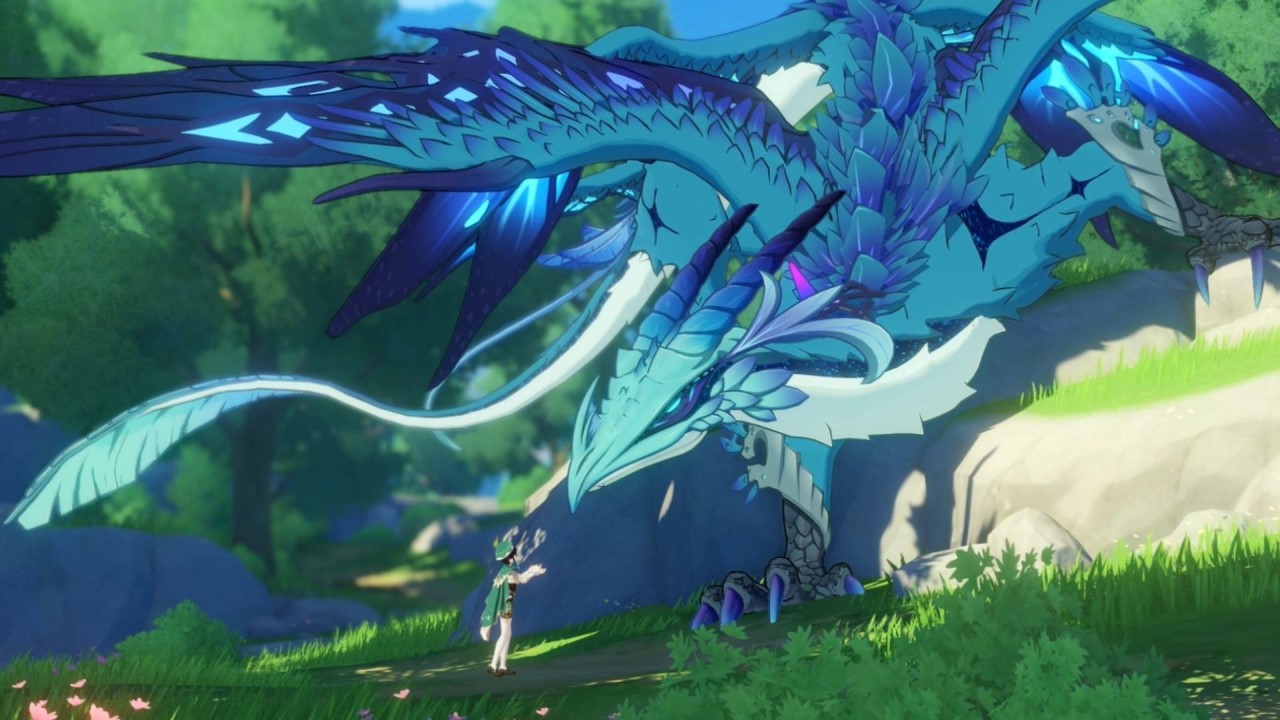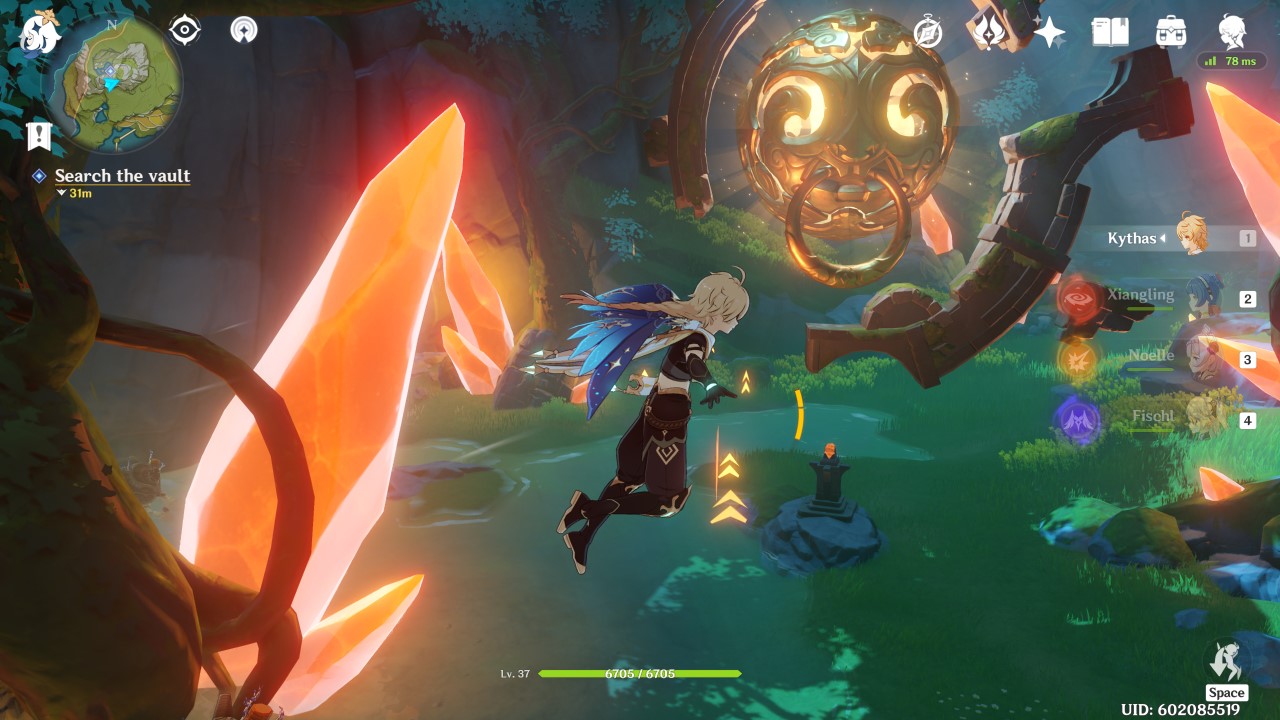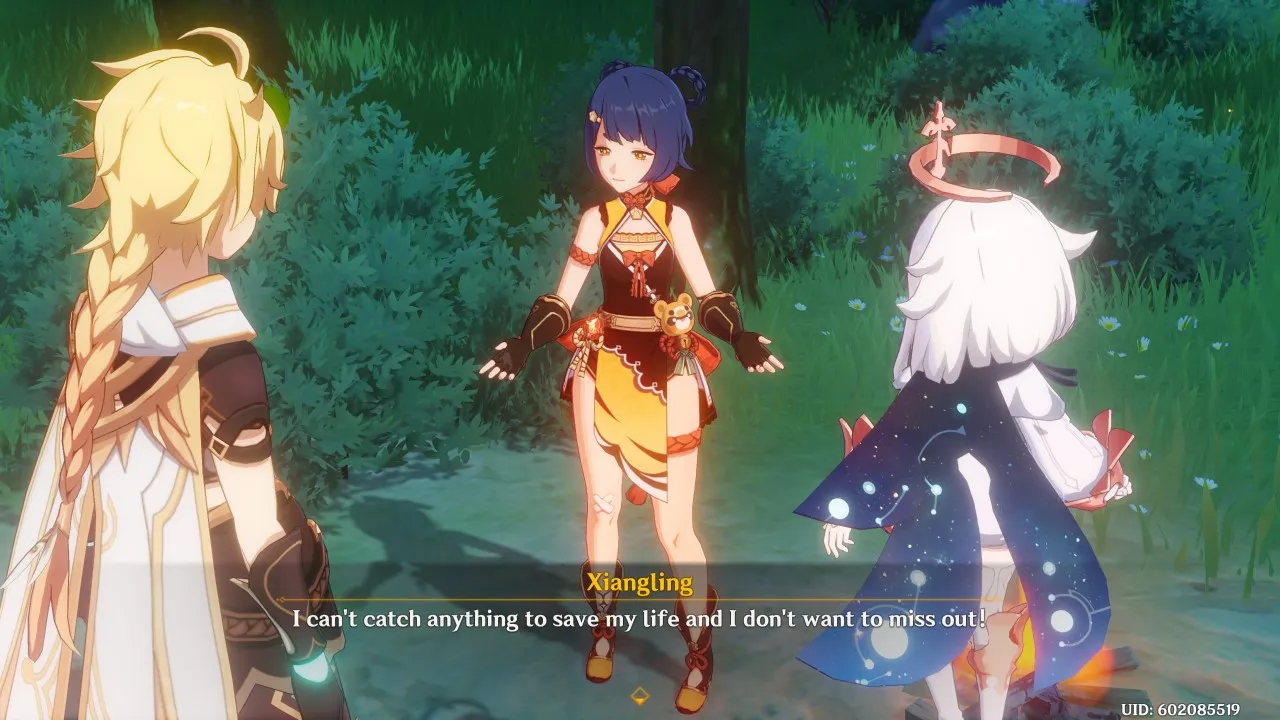Genshin Impact is a game with two conflicting identities. It’s a gorgeous open-world RPG that adopts much of what made Nintendo’s Breath of the Wild outstanding while carving a niche all its own. It’s also a remarkably greedy gacha game, even when compared to more traditional gacha games. Genshin Impact has the potential to become an industry juggernaut played by millions for years to come, but its underlying gachapon core may tragically push players away if its not adjusted to better match Genshin’s AAA-caliber gameplay.
Genshin Impact: More than a Breath of the Wild clone.
As many of you have no doubt noticed by now, Genshin Impact generated much of its initial reputation by virtue of being obscenely similar to The Legend of Zelda: Breath of the Wild. A vast, colorful open-world you are free to explore? Check. The ability to climb on virtually any surface, and a wind-glider for navigation? Also check. How about a stamina bar that factors into everything from climbing, swimming, gliding, sprinting, and even combat? You get the general point: Genshin Impact proudly flaunts its inspiration without even an iota of shame.
Thing is, Genshin Impact isn’t a clone. It certainly borrows liberally from Nintendo’s landmark title (to include a few on-the-nose cinematic moments), but it does enough differently to stand on its own. The first major departure from Breath of the Wild is the general aesthetic. Sure, Breath of the Wild also featured cell-shaded graphics that lent it a more cartoonish, yet stylized appearance, yet Genshin Impact looks damn near like an actual anime. I’m talking, “blink, and you may confuse this for a modern Tales game,” anime. Characters in Genshin are not as over the top as those found in games as hyper-anime as Phantasy Star Online 2, yet they still pop with sharp colors, crisp lines, and wonderfully unique design quirks.
It’s important that each character has a distinct visual motif, because Genshin Impact possesses a full-blown story that’ll carry players through the game. There’s some weird account-level gating I’ll talk about a bit further down, but it’s otherwise what you’d expect to see in a RPG: a tale of fantastic circumstances where we may or may not have to eventually kill a god. While the framework of Genshin Impact’s narrative isn’t entirely new, the writing and cast of characters are all exceptionally well realized. As tropey as some may be (looking at you, Lisa), each is voiced with care and consideration, and even early annoyances like Paimon eventually grew on me. Yes, Paimon is emergency food, but if anyone lays a hand of her I shall catapult them off the tallest mountain in Teyvat.

The world of Teyvat is a touch more subdued than the characters, but no less impressive. The mobile-first approach to Genshin Impact’s development is given away by the short draw distances, muddy environmental textures, and touch-friendly UI, but color and lighting are used to such great effect that you’ll often overlook what fidelity issues are present. Genshin Impact may not be a technical showcase, but the art and world design are nothing short of stunning. Does the world itself reach the same heights as Breath of the Wild’s? No, but Teyvat comes close to touching that impossibly high bar, and the map is littered with a bevy of secrets to uncover, all cleverly tied together by subtle “breadcrumb” trails similar to what we saw in Hyrule a few years ago.
The initial zone of Mondstadt is impressive, yet a touch routine. It’s rolling hills, sharp cliffs, and pockets of tall grass look great, and there’s plenty to uncover and “squirrel” over (such as the totally-not-Bokoblin camps), but Mondstadt can’t help but feel a little generic. Then you cross the border into Liyue, and find yourself surrounded by tall mountains and vast planes bordered by a massive bay. The colors take on more autumnal hues, and the ancient-Chinese vibe that dominates the zone highlights miHiYo’s artistic talent. It’s a world that frequently awes, even after it becomes a bit mundane due to the sheer scope of it all. Also, you don’t slip down mountains while climbing in the rain – that’s a plus far as I’m concerned.
Combat is another area in which Genshin Impact and Breath of the Wild vastly differ. Breath of the Wild had what I’d call relatively simple combat that became a dazzling display of creativity once players figured out how to weave the game’s intricate physics system into it. Genshin Impact is full-blown ARPG bombast right out of the gate. Characters have a basic attack, a charge attack, an elemental attack, and elemental “super”. Every character has their own kit and a set weapon-type as well, providing a robust array of combat diversity out of the gate. That’s fine and dandy on paper, but what makes combat tuly sing in Genshin Impact are the elements and their various combinations.
Every character in Genshin Impact, the main character aside, is assigned a single element. Powerhouse damage-dealer Diluc is a firebrand that can ignite his massive claymore with deadly flames. Cheery idol/priestess Barbara uses water to heal her teammates, and to damage enemies from afar. Setting an enemy on fire with Diluc, then swapping to Barbara to “Vaporize” the flames deals bonus damage, and that’s just one of the simpler combos. Outside the occasional “guest” character, player parties will always consist of four different characters, and despite playing as only one at a time, you can swap near instantaneously to anyone, combining different element skills, supers, and empowered base attacks to decimate the packs of enemies that dot Teyvat.

Genshin Impact is also a much deeper RPG than Breath of the Wild by a long shot. You have character, weapon, and Artifact (gear) levels to increase, and the set bonuses and randomized attributes on Artifacts encourage farming. Every character has an array of talents to unlock, which require materials found out in the world. Hell, everything requires some kind of material farmed from one explicit source or another. During the early hours this grind wasn’t problematic, and I enjoyed having to manage my party to optimize performance. I’m an RPG nerd, so this aspect of Genshin Impact tickled my fancy more than Breath of the Wild’s relatively staid equipment system ever did (that, and the omission of weapon durability is another improvement in my book).
Speaking of materials and farming, Genshin Impact also has shrines of a sort (Domains), though they are far, far fewer in number than what we saw in Breath of the Wild. They’re also less concerned with solving puzzles, typically involving some form of platforming and a whole lot of combat. The combat is sublime enough that this repetition isn’t a huge issue while playing through the story, but the lack of variety among the Domains does become a problem later in the game. That’s because Domains are where you’ll spend most of the late-game farming for upgrade materials for characters, weapons, talents, and Adventure Rank experience.
If some of the late-game stuff I’ve describe sounds a wee bit like the usual “live service” foreplay, that’s because it is. Problem is, all of it is filtered through what is perhaps the stingiest gachapon mechanics I’ve seen in a while. I’ve witnessed more than a few people defend the gacha half of Genshin Impact, usually spouting the same tired, “this is what gachas are like, get over it,” excuse over and over again. Here’s the rub: Genshin Impact may be marketed as a mobile gacha game by miHoYo, but they made an actual, honest-to-goodness game.
Genshin Impact isn’t just some slot machine disguised as a glorified auto-battler.
Genshin Impact isn’t just some slot machine disguised as a glorified auto-battler, where choosing your team and what equipment they will carry into battle is the deepest layer of decision-making available. Genshin easily puts some recent heavy-hitters to shame, to include Nintendo’s recent Pokemon titles. Call it a mobile gacha game all you want, but Genshin is anything but. The game is on PC and PlayStation 4, and while performance on the latter needs work, the game runs flawlessly on my PC at max settings. I wouldn’t mind an uncapped framerate (it’s currently capped at 60 FPS), and the ability to remap keybindings, but I much prefered playing Genshin with a mouse and keyboard than with touch controls on my phone.
Ignoring the gacha elements, Genshin Impact is easily one of the best games released this year. It features a vast open-world that invokes a genuine sense of wanderlust, snappy combat bolstered by an intelligent elemental system, and a story that, while generally generic, features a well realized cast of characters that makes it worth pursuing. The graphics are crisp, the animations fluid: the production values for Genshin easily outshine other similar games within the RPG genre this year. And for the low, low price of nothing, you can easily wring 40 to 60 hours of enjoyment out of the game. Genshin Impact also has the legs to go further, to become a game millions of players dump hundreds, if not thousands, of hours into. But the damned gachapon portion of the game seems intent on pushing all the mainstream, non-gacha players that have flocked to the game away.

Genshin’s gacha is stingy, even by gachapon standards.
For those unfamiliar, “gacha” games are a form of game where the primary form of monetization involves some form of gambling for high-rank characters and equipment. I’m not going to sugarcoat gacha for what it is: it’s gambling. Each spin of the reels is even called a “pull” for Teyvat’s sake. There are other mechanics that make-up a gacha game, but the gambling for characters and items is by and large the genre’s most defining trait.
Genshin Impact is very much a gacha in this regard. There are “banners” to pull from, and one of them is of course on a timer to maximize player anxiety and FOMO. By and large, if you want to play with a new character in Genshin Impact you need to pull the handle on the slot machine and pray someone, anyone drops. There are a couple minor exceptions, but you’re gonna need to gamble if you want to expand your party. The game provides the requisite in-game currency rather liberally early on, but it naturally begins to evaporate as you get deeper into the game. That, and considering you need duplicates to level what are known as Constellations (powerful passives for each character that alter how they play), miHoYo made sure there’s always a tempting reason to throw money into the pot.
And it’s a deep pot. In the current limited banner the marque character, Venti, has a 0.6% rate. That’s fucking abysmal well before you realize that’s the drop rate for all 5-stars in the banner. Oh, but don’t worry, there’s a pity mechanic! If you don’t get Venti by pull 90 you’re guaranteed at least one 5-star character (the highest tier of character in Genshin Impact). But, it’s a 50/50 shot whether or not it’ll be him. Don’t you fret, because at pull 180 you will get Venti, promise. At least the game gives you enough currency during the early hours to grab a character or two from free pulls, but there’s a reason the drop rates are as low as they are. . . .
You know why the drop rates are ass, but allow me to spell it out.
To get Venti on pull 180, you’ll have spent roughly $445 dollars, excluding bonus “currency”. That’s a PlayStation 5! All for a character that you may or may not enjoy playing because every character in Genshin has their own unique set of abilities and passives to play with. I know the gacha faithful are rolling their eyes at me right now, and I get it: this is relatively par the course for gachas.
Thing is, Genshin Impact is such a robust, fully featured game outside the gacha bullshit that it has attracted a large number of mainstream gamers who have probably never played a gacha game before, and have no idea how terrible these drop rates are. A quick look across the genre and it’s clear Genshin Impact’s drop rates are trash when compared to contemporaries like Dragalia Lost, Arknights, and even miHiYo’s own Honkai Impact 3rd. But, hey, gotta create new addicts somehow.
Of course, the greedy gacha mechanics don’t end there. Gachas all tend to have what can be referred to as a “stamina” system that dictates how much you can play in a day. During the early hours of Genshin Impact its equivalent, Resin, is easy enough to ignore, but once you exhaust the world of its secrets and have cleared most of the story you’ll find yourself locked to roughly an hour of play a day. You can always pay money to restore some of your Resin (through two layers of different currencies, because we have to obfuscate the actual monetary value of things), yet Genshin Impact’s stamina is too limiting as it is.
That’s because Genshin Impact has plenty of items worth grinding for after you’ve cleared the map and story. Adventure Rank is your global account level, and it dictates access to domains, co-op, and even story missions. Needless to say it’s important to level your Adventure Rank, and at roughly Rank 30 – when you’ve likely found everything on the map and wrapped up most the story – progress comes to a screeching halt. Farming chests that respawn in the world does net you some Adventure Rank exp, but it’s in meager amounts. If you want to make actual tangible progress you will need to complete your four daily commissions, then burn Resin due to how it gatekeeps rewards.

See, you can run any Domain, pop any Ley Line, or tackle any weekly boss you so desire without Resin. You won’t get any rewards for the effort though! Assuming you enjoy actual progression in your video games, you’ll need Resin on hand to claim any of the rewards, to include the Adventure Rank experience tied to that activity. So, Resin is effectively blocking two forms of progression: your overall Adventure Rank (and, in effect, additional content), and the materials/Artifacts you need to power-up your characters.
Again, I hear ye gachapon faithful, with your tired, “it’s a gacha, you’re not supposed to play it all day.” And I’m here to remind you that even by that standard, Genshin Impact’s stamina system remains hot garbage. Other gacha’s provide players ways to continue playing for hours on end without spending a dime to replenish their stamina, whether by reducing rewards when they’re out of stamina, through increasing the stamina cap with each account level, or by providing free refresh items through daily quests, etc., and etc..
Genshin Impact is a fantastic open-world RPG people want to keep playing, that much is evident. It’s immense production value, massive scale, and superb quality elevate it well beyond the “it’s a mobile gacha game; deal with it,” excuse being parroted by some. miHoYo may believe that all they want, but they still went all out and created a top-tier AAA-caliber game. Genshin being on phones doesn’t alter the conversation either: this is not a mere mobile game. You don’t hire the London Philharmonic to record the arguably excellent and varied score if you’re simply making a “mobile gacha game.”
It even has the foundation and hooks of a solid live-service game built in, and mainstream players who’ve fallen in love with Genshin’s world and characters want to take advantage of them. They want to grind out character and weapon levels, to farm upgrade materials and full Artifact sets until their fingers fall off from fatigue. But Genshin’s gacha is so stingy – even by industry standards – eager players can’t progress more than an hour a day without either paying up, sacrificing the currency they need to also make character pulls, or by farming generic chests and regular bosses until they collapse from the tedium of it all. Throw in the randomized attributes on some drops and you have a system that encourages people to walk away from the game entirely, rather than deal with all the time-gated bullshit.
miHoYo made a AAA-quality title, full-stop. Genshin may not be an MMO, nor a traditional GaaS, but it competes more directly with those games than it does gachas. Hell, Genshin Impact is a better live-service game than Marvel’s The Avengers, and that had the world’s largest IP behind it. Despite this, miHoYo decided to monetize Genshin Impact like a low budget mobile gacha game, and this mismatch is glaring. Add in the Battle Pass and optional sub, and all Genshin Impact is missing from the monetization bingo card is a cosmetic shop.
I’m not alone in this regard. Players have brought up similar complaints on the official subreddit since the “honeymoon” period started to end a few days ago. Chinese players have gone as far as to review-bomb the game. Of course, the faithful have gone well out of their way to defend miHoYo’s terrible gacha rates and stamina system, but they’re missing the forest for the trees. Yes, Genshin is a gacha, but that doesn’t magically redeem the gacha elements. They can be, and should be improved upon if Genshin is to be more than just “another mobile gacha game.”
Right now people are starting to bounce off the game once they realize they can only play for an hour or two a day without spending money, and that’s a shame. Genshin Impact is easily one of my top games of the year, and I want to dump more time into it. Even if it’s for half the rewards and no Adventure Rank experience, I’d gladly grind Domains in co-op all day for the items I need. Genshin would need a few more activities to round out the “end-game”, but it’s already on the right track. With additional zones, story, and characters on the way, it’s clear miHoYo want people to stick around. Genshin could be a dominate player in the live-service arena, yet miHoYo appears content pandering to the usual gaggle of gacha whales.

The Verdict.
Despite its often less-than-subtle nods to Nintendo’s Breath of the Wild, Genshin Impact does enough differently to stand apart. It’s also proof that Nintendo’s approach to open-world design wasn’t mere lightning in a bottle. Teyvat is nearly as delightful to explore as Nintendo’s Hyrule, which is no light praise. Throw in punchier combat, a more traditional story packed with interesting characters, and an outstanding score and Genshin Impact easily sits among the upper echelon of games released this year. Often I’d ask myself, “how is this free?,” and after roughly 60 hours of play I’m still surprised by every new secret I uncover.
Then the gacha mechanics kick me in the shins, and I’m reminded why Genshin is free-to-play. Genshin Impact has amazing potential going forward, yet exploitative gacha mechanics may ultimately eclipse that bright future. Genshin is a fantastic game bogged down by mobile game monetization. Genshin Impact suffers from a split identity: is it a proper, meaty AAA experience built by over 400 people, or yet another mobile cash grab that’ll fade into obscurity? Hopefully miHoYo relaxes the stamina system and gacha rates soon, because Teyvat is a world absolutely worth revisting. They’re just making it difficult for anyone but gacha fans to find the motivation to hold on.











Published: Oct 8, 2020 06:35 pm